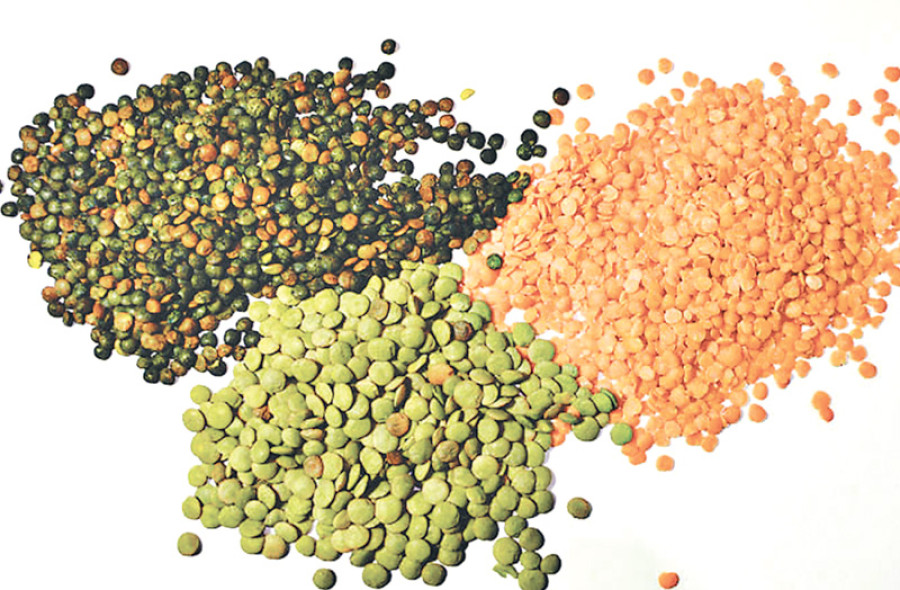Money
Nepal world’s 5th largest lentil producer in 2014
Nepal became the world’s fifth largest producer of lentils in 2014, moving up one spot from 2013 after US lentil output suffered a sharp drop of 33 percent.
Sangam Prasain
Nepal became the world’s fifth largest producer of lentils in 2014, moving up one spot from 2013 after US lentil output suffered a sharp drop of 33 percent.
According to the Food and Agriculture Organization (FAO) of the United Nations, Nepal produced 226,830 tonnes of lentils in 2014 to take the fifth place behind Canada, India, Australia and Turkey. In 2010, Nepal’s output totalled 151,757 tonnes, placing it in the fifth position.
The FAO’s statistics show that Nepal’s lentil output stood at 206,969 tonnes in 2011, 208,201 tonnes in 2012 and 226,931 tonnes in 2013.
The country accounts for nearly 4.64 percent of the world’s total output of lentils. In South Asia, Nepal’s share comes to 16 percent. The global lentil output was recorded at 4.88 million tonnes in 2014, down from 5.30 tonnes in 2013.
The common variety grown in Nepal is ‘masoor’. It has a brown skin and is orange inside.
Meanwhile, the area under lentil cultivation increased 0.28 percent to 205,939 hectares. Lentils are produced in all the districts in the country except Manang and Mustang.
Commercial production, however, is concentrated in the Tarai. More than 90 percent of the lentils grown in Nepal comes from this region because of its favourable climatic and soil conditions. Sarlahi, Rautahat, Bara, Dang, Kailali and Bardia are the top lentil producing districts.
The revised Nepal Trade Integration Strategy (NTIS) 2016 has prioritized lentil as one of the 12 commodities with high export potential in Nepal. Bangladesh is the largest buyer of Nepali lentils.
“Demand for Nepali lentils is growing in India and Europe as well due to their high nutrition level,” said Shankar Sapkota, a senior agriculture economist at the Ministry of Agricultural Development. “There is demand for the product globally, but we have not been able to tap the potential,” he said.
Sapkota said that the ministry was preparing programmes under its recently launched Prime Minister’s Agriculture Modernisation Project to boost lentil output by creating blocks and pocket areas. There are many constraints to boosting output like lack of improved inputs, technology and skills.
Yubak Dhoj GC, director general of the Department of Agriculture, said that Nepal could double production if an intensive programme was focused on lentils. “Obviously, improved variety of seeds and technology will be key to achieving higher yields,” he said.
Chemical fertilizers and ploughing are not necessary to grow lentils. Lentils absorb nitrogen from the air so farmers do not need to apply urea to their fields. Good quality lentil seeds do not need any special treatment like other crops.
“However, the worrying factor is that due to commercial use of chemical fertilizers, nitrogen-fixing bacteria or soil bacteria that fix nitrogen inside root nodules of legumes are becoming inactive, thus reducing the productivity of lentils,” said GC.
“Farmers have been made aware of this issue and provided knowhow about its treatment, but it has not been widely effective.”
Lentil exports have also been dropping gradually in the last few years. According to the Trade and Export Promotion Centre, Nepal exported 7,611 tonnes of lentils worth Rs1.29 billion in 2015-16, down from Rs2.04 billion in 2013-14. In 2008-09, lentil exports reached 56,767 tonnes valued at Rs5.66 billion to become the country’s largest export.
Exports shrank to 37,569 tonnes worth Rs3.47 billion after the government banned shipments in 2009-10 citing a possible food deficit. After entrepreneurs assured the government that exports would not affect the country’s food supply, it lifted the restriction. In 2010-11, exports amounted to 37,425 tonnes worth Rs3.34 billion.
GC said that due to increased domestic consumption, exports had been falling gradually.
TOP PRODUCERS
Country Output (tonnes)
2013 2014
Canada 2,172,800 1,987,000
India 1,134,000 1,100,000
Australia 324,100 348,080
Turkey 417,000 345,000
Nepal 226,931 226,830
China 150000 153,000
USA 227,660 152,720
Ethiopia 159,121 137,354
Bangladesh 93,000 98,210
Iran 80,000 78,500
Syria 124,764 70,907
(Source: FAO)




 11.12°C Kathmandu
11.12°C Kathmandu













